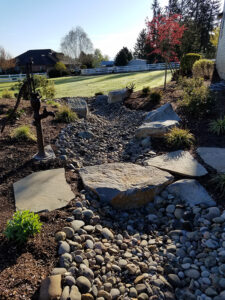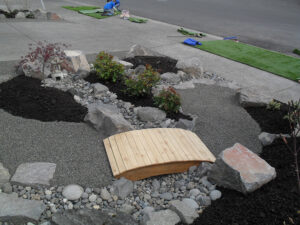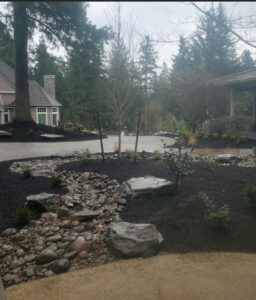Dry Streambeds for Nature-Inspired Landscapes
 The Pacific Northwest is known for its natural beauty with soaring trees, green farmland, sprawling streams, and cascading waterfalls. It’s no surprise that our residents often want to capture that nature-inspired awe right in their own backyard. While we can’t mimic exactly what you see on a trip through the Columbia River Gorge, the team at Landscape East & West can bring a year-round natural feel to your own backyard through a well-placed dry streambed.
The Pacific Northwest is known for its natural beauty with soaring trees, green farmland, sprawling streams, and cascading waterfalls. It’s no surprise that our residents often want to capture that nature-inspired awe right in their own backyard. While we can’t mimic exactly what you see on a trip through the Columbia River Gorge, the team at Landscape East & West can bring a year-round natural feel to your own backyard through a well-placed dry streambed.
As the name implies, a dry streambed is meant to look like just that: a natural stream that has dried up. It typically consists of a shallow, winding trench filled with stones. The stones, gravel, and boulders used, along with natural plants along the borders, are meant to mimic the flow of water. In some cases, they even capture and direct rainwater that flows through a property. They can serve both a strictly aesthetic purpose and a solution for practical drainage problems.
Aesthetic Purposes
Dry streambeds offer a natural design element that brings structure and flow to the landscape. Their winding shape guides the eyes toward different parts of the yard, giving the illusion of movement. Filled with stones and surrounded by native plants, they provide year-round visual interest and texture and can break up flat and monotonous spaces. They can be used in addition to or as a replacement for paths and stepping stones to create natural boundaries between different spaces of your yard and form a more cohesive look.
Functional Purposes
 While a dry streambed does not ever have to fill with water, it can when needed, making it a potential solution to divert runoff, reduce erosion, and prevent pooling in yards with poor drainage. On sloped properties, a dry streambed can slow the flow of water, minimizing erosion and soil compaction. In yards where heavy rain leaves behind ponding, a dry streambed can divert the water.
While a dry streambed does not ever have to fill with water, it can when needed, making it a potential solution to divert runoff, reduce erosion, and prevent pooling in yards with poor drainage. On sloped properties, a dry streambed can slow the flow of water, minimizing erosion and soil compaction. In yards where heavy rain leaves behind ponding, a dry streambed can divert the water.
Outside of its purpose for water control, a dry streambed, especially when surrounded by native plants, can attract wildlife to create a mini-ecosystem of beneficial insects, birds, and even butterflies. The benefits of habitat creation and water management, plus a beautiful natural aesthetic that requires minimal maintenance, are the reasons dry streambeds are gaining in popularity.
If you want to see if a dry streambed will work in your yard, contact us for a free consultation. Together, we’ll explore your yard, determine your tastes, and design a streambed that works best in your space.
Our process:
1. Plan the Streambed Path
Our designers will visit your yard while it’s raining to observe where the water naturally flows or pools. Our goal is to place the streambed along low-lying areas to improve drainage.
Next, we’ll look at creating curves to give the path of the streambed a natural winding look. Real streams seldom flow in a straight line.
We’ll explore the natural slope of your yard and determine if more is needed. The streambed should gently slope to direct the water flow where you want it. We aim for a slope from a few inches to a foot, depending on the drainage needs in your yard.

2. Choose Stones and Gravel
The streambed will be lined with a variety of rocks to create a realistic effect. We use larger rocks along the banks and shore edges to provide a more defined boundary. Smaller stones and gravel are placed into the center, so water flow isn’t impeded. Boulders can be placed along the edges as well to create focal points and add to the natural feel of the streambed. With a variety of rock shapes, sizes, and colors to choose from, our designers will work closely with you to make choices that reflect your taste.
3. Add Plants Along the Streambed
Our team will help you select a variety of plants to add interest and add in soil stability along the streambed. Plants native to the Pacific Northwest, like Oregon grape or sword ferns, will thrive year-round, giving you a beautiful landscape even in the dreary winter months. For streambeds that aren’t always dry, moisture-loving plants like sedges, irises, and rushes are good picks.
For a true dry streambed, we’ll choose drought-tolerant plants like lavender and ornamental grasses to add texture while also creating habitats for beneficial insects and birds. A streambed with butterflies and hummingbirds floating by gives a landscape instant appeal.
 4. Enhance with Mulch and Ground Cover
4. Enhance with Mulch and Ground Cover
A final touch is to add mulch and ground cover. Mulch will help plants retain moisture, and ground covers like creeping thyme or moss will soften the edges of the dry streambed and further create the desired natural look.
Overall, dry streambeds are an attractive, versatile landscaping feature that brings both form and function to your yard, especially if you aim to create a natural, low-maintenance landscape. You could pair a streambed with a gazebo or a firepit to form a welcome retreat. It could run along the side of your home to add interest to an area that’s sometimes neglected. You could even place a fountain or waterfall feature at the end of the streambed to further enhance the water theme.
A dry streambed offers many possibilities for building a landscape that may remind you of days spent in the forest. Even if you’re just looking for something unique to solve your drainage problems, consider a dry streambed. Contact Landscape East & West for a free consultation to learn more about this feature and all the other landscape services we offer.
